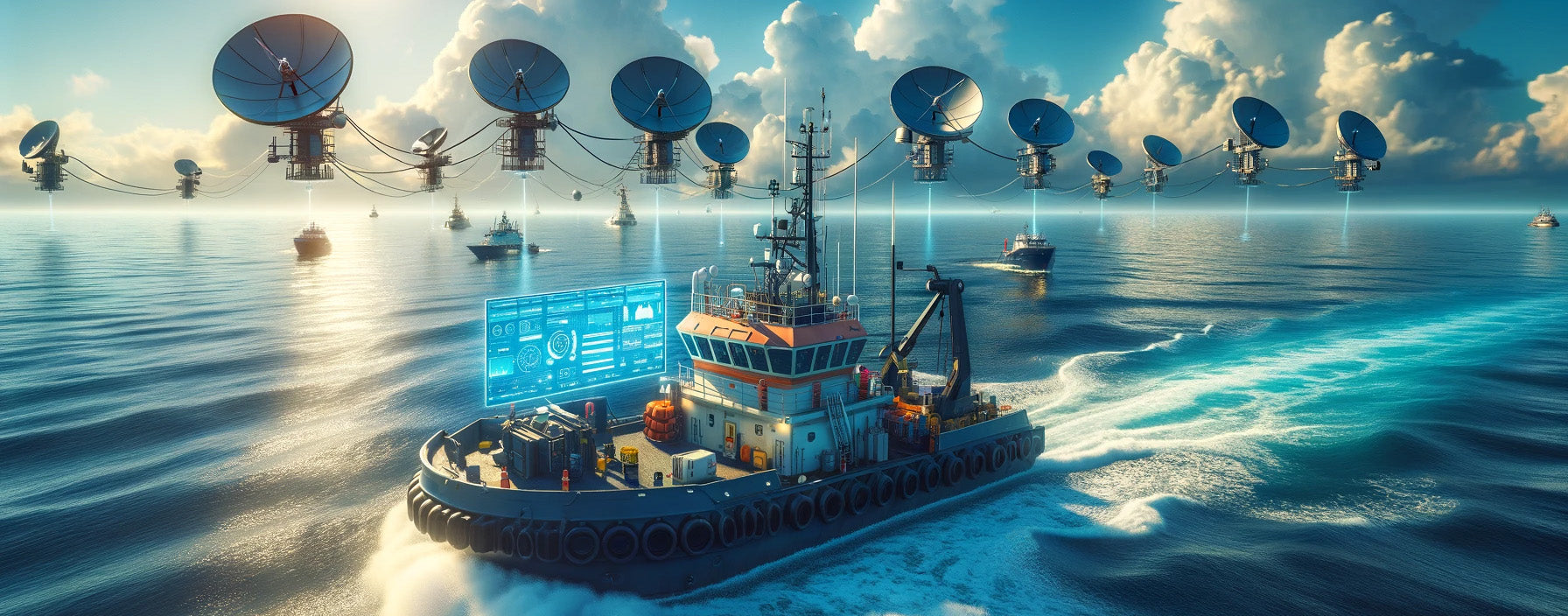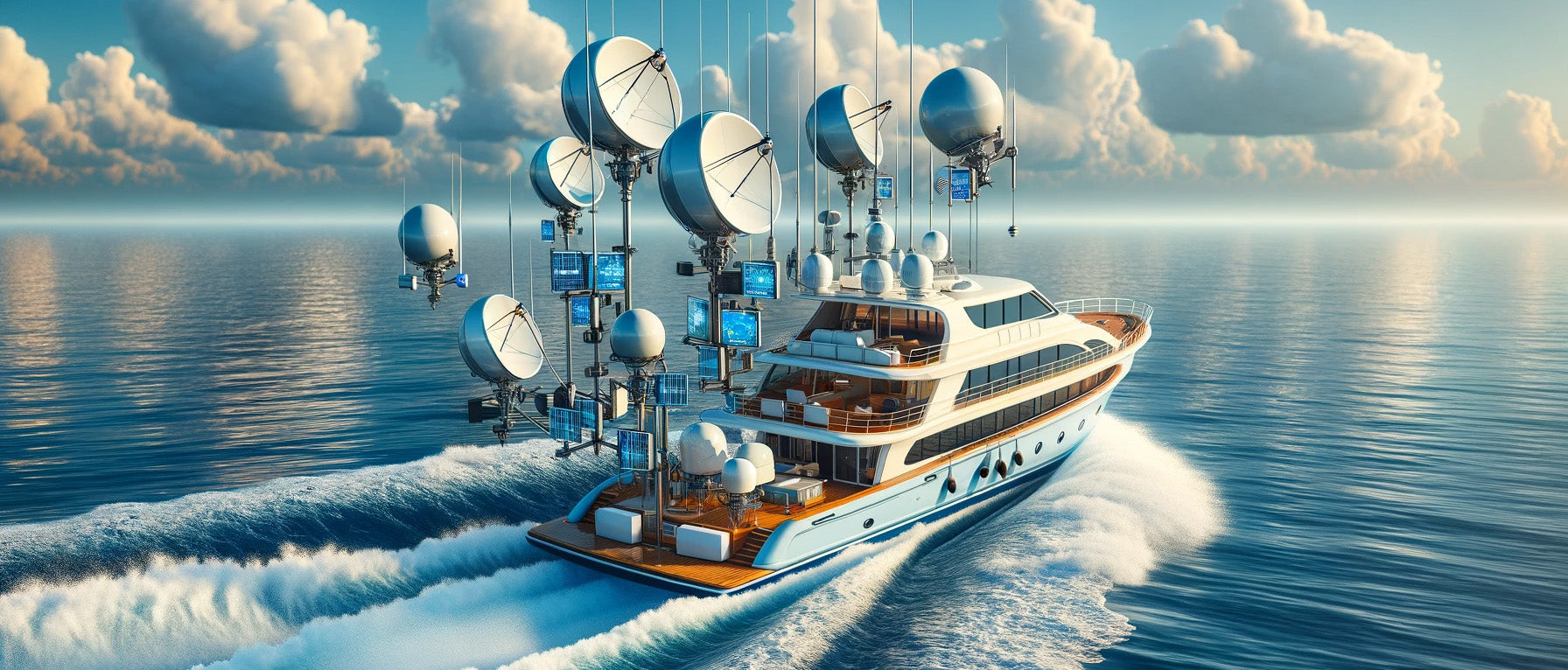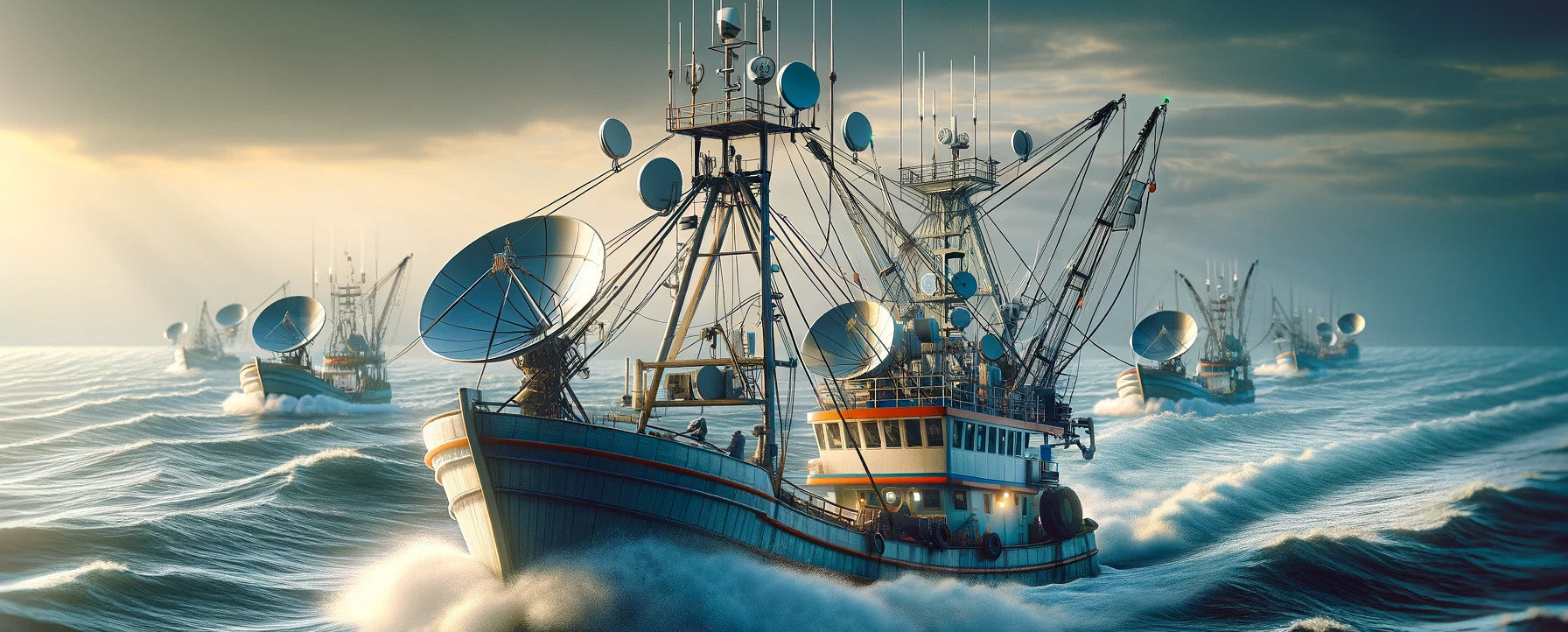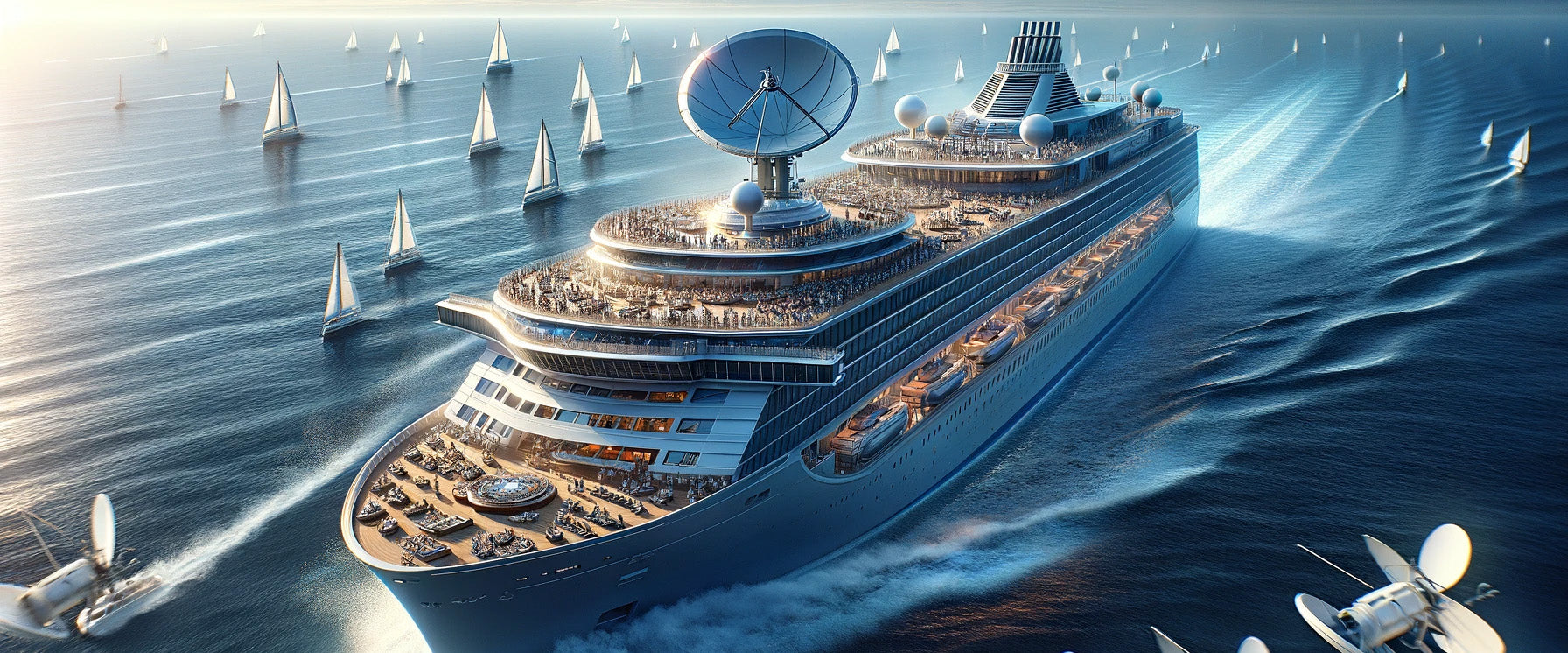
Satellite Networks and the Maritime Market
- 06 Mar, 2024
- Posted by: Michael Mathison
Satellite Networks and the Maritime Market
Satellite networks have revolutionized the maritime market by enhancing communication, safety, and navigation across the world's oceans. By providing reliable connectivity even in the most remote marine environments, satellite technology enables ships to stay in touch with shore-based operations, receive real-time weather updates, and access navigational data crucial for safe passage. This global coverage is indispensable for coordinating international shipping routes, conducting maritime rescue operations, and supporting the fishing industry.
Additionally, satellite networks facilitate the monitoring of maritime traffic and the enforcement of international maritime laws, contributing to more efficient, safe, and sustainable marine operations. The integration of satellite communications into the maritime market underscores the vital role of advanced technology in the modernization and globalization of maritime activities.

Merchant Shipping
Satellite networks have revolutionized merchant shipping within the maritime market, impacting various aspects of operations, communication, and safety. These networks provide critical services that enhance the efficiency, reliability, and safety of shipping operations worldwide. Below is an explanation and list of how merchant shipping is affected by satellite networks:
Explanation:
Satellite networks offer unprecedented global coverage, enabling ships to maintain communication far from land and in all weather conditions. This connectivity is vital for navigation, operational management, and emergency responses. It allows ships to access real-time data, including weather forecasts, navigation alerts, and port information, ensuring safer and more efficient voyages.
Furthermore, satellite networks support the digitalization of the maritime industry, facilitating the adoption of advanced technologies like automated identification systems (AIS), electronic chart display and information systems (ECDIS), and fleet management software. These technologies rely on satellite communication to function effectively, transforming traditional shipping operations into modern, high-tech endeavors.
How Merchant Shipping is Affected:
-
Enhanced Communication: Enables constant contact with shipping companies, port authorities, and other vessels, improving coordination and operational efficiency.
-
Improved Navigation and Safety: Provides access to GPS data, weather updates, and sea condition forecasts, allowing for safer routing and voyage planning.
-
Emergency Response: Facilitates immediate communication in emergencies, crucial for coordinating rescue operations and ensuring the safety of crew and cargo.
-
Crew Welfare: Offers internet access, email, and calling services to crew members, helping maintain morale and reduce isolation during long voyages.
-
Operational Efficiency: Supports real-time tracking and monitoring of vessels, fuel management, and cargo handling, leading to optimized operations and reduced operational costs.
-
Regulatory Compliance: Aids in meeting international maritime safety and environmental regulations by enabling the transmission of log data, vessel monitoring, and reporting in real-time.
-
Market Responsiveness: Allows shipping companies to quickly adjust to market changes, port delays, and customer demands by providing timely and accurate information.
-
Cybersecurity: Satellite communication networks enable the implementation of cybersecurity measures to protect ships from cyber threats and ensure the security of maritime data and systems.
In summary, satellite networks are integral to the modern maritime industry, providing the backbone for communication, safety, and operational management in merchant shipping. These networks not only facilitate a higher degree of safety and efficiency but also support the welfare of crew members and compliance with regulatory standards, marking a significant shift towards a more connected and technologically advanced maritime sector.

Workboats
Satellite networks have become a fundamental component of maritime operations, significantly impacting workboats—ranging from tugs and supply vessels to fishing boats and offshore service vessels. These networks enhance safety, efficiency, and connectivity, even in the most remote maritime environments. Here's an explanation followed by a list of how workboats in the maritime market are affected by satellite networks:
Explanation:
Satellite networks provide vital communication links for workboats, enabling them to operate more safely and efficiently. Through these networks, vessels can access real-time data for navigation, weather forecasts, and sea conditions, crucial for planning and executing maritime operations. Satellite communications also facilitate emergency responses, allowing workboats to quickly call for help or coordinate with other vessels and shore-based operations.
Moreover, these networks support operational logistics, including route optimization and fleet management, by providing continuous connectivity. For crews, satellite networks offer a lifeline to the outside world, crucial for morale during extended periods at sea.
How Workboats are Affected:
-
Enhanced Navigation and Safety: Access to GPS and real-time weather data helps workboats navigate safely and avoid hazardous conditions.
-
Improved Communication: Constant connectivity with shore-based operations and other vessels for coordination and support.
-
Emergency Response: Quick and reliable means to communicate with rescue services during emergencies.
-
Operational Efficiency: Real-time data exchange for logistics, route planning, and fleet management, optimizing operations and fuel usage.
-
Regulatory Compliance: Enables reporting and compliance with maritime regulations through electronic reporting systems.
-
Crew Welfare: Provides crew members with communication services to stay in touch with their families and access entertainment, reducing isolation.
-
Remote Monitoring and Maintenance: Satellite connectivity allows for the remote monitoring of vessel conditions, facilitating preventive maintenance and reducing downtime.
-
Fisheries Management: For fishing vessels, satellite networks support sustainable practices by providing access to fish stocks data and monitoring systems.
-
Market Responsiveness: Enables workboats to quickly adapt to market demands and operational requirements through timely access to information.
-
Cybersecurity: Supports the implementation of cybersecurity measures to protect sensitive data and communication from threats.
In summary, satellite networks are crucial for the modern maritime market, particularly for workboats, enhancing their operational capabilities, safety, and the well-being of crews. These networks ensure that workboats can perform their essential roles in the global maritime industry, from transportation and logistics to fishing and offshore services, with greater efficiency and reliability.

Autonomous Vessels
Autonomous vessels represent a significant advancement in maritime technology, relying heavily on satellite networks to operate efficiently and safely. These networks are vital for navigation, communication, and data exchange, fundamentally enabling the operation of unmanned ships across the globe. Below is an explanation and list of how autonomous vessels are affected by satellite networks:
Explanation:
Satellite networks provide the backbone for the communication systems of autonomous vessels, offering wide coverage and reliable connectivity that is essential for these ships to navigate the vast and often treacherous seas. Through satellites, autonomous vessels can receive real-time data on weather conditions, sea traffic, and navigational hazards, ensuring safe passage.
They also enable the remote control and monitoring of these vessels by operators located thousands of miles away, ensuring that human oversight is maintained. Furthermore, satellite communications support the transmission of operational data between the vessel and shore-based facilities, allowing for continuous performance optimization and maintenance planning.
How Autonomous Vessels Are Affected by Satellite Networks:
-
Global Navigation and Positioning: Satellite networks provide precise location data, enabling autonomous vessels to navigate accurately across the open sea.
-
Real-time Communication: Essential for remote monitoring and control, satellite networks allow operators to make timely decisions and adjustments to the vessel's course and operations.
-
Weather and Environmental Data: Access to up-to-date weather and oceanographic data helps autonomous vessels avoid hazardous conditions and optimize routing for efficiency and safety.
-
Collision Avoidance: Satellite communication systems integrate with other technologies to identify and communicate with nearby vessels, supporting collision avoidance systems.
-
Data Transmission: The ability to send and receive large volumes of operational data in real-time supports the continuous improvement of autonomous navigation systems and maintenance needs.
-
Emergency Response: In case of malfunctions or emergencies, satellite networks provide a critical link for transmitting alerts and coordinating rescue or intervention efforts.
-
Regulatory Compliance: Satellite communications enable autonomous vessels to comply with international maritime regulations by transmitting log data and other required information to regulatory bodies.
-
Crew Welfare (for Partially Autonomous Vessels): On vessels that are not fully autonomous and still carry crew for certain operations, satellite networks support crew welfare by providing internet access and communication with the outside world.
In summary, satellite networks play a crucial role in the development and operation of autonomous vessels within the maritime market. They not only ensure the vessels' safe and efficient operation but also facilitate the necessary human oversight and control over these advanced technological systems, bridging the gap between innovation and safety in maritime navigation.

Leisure Boating
Satellite networks have significantly impacted leisure boating in the maritime market, enhancing safety, navigation, communication, and overall boating experiences. Here's an explanation and list of how leisure boating benefits from satellite networks:
Explanation:
For leisure boating enthusiasts, satellite networks provide a crucial link to safety, navigation accuracy, and communication, transforming how individuals enjoy the open water. Unlike traditional radio systems with limited range, satellite communication ensures that boaters remain connected even in the most remote parts of the oceans.
This connectivity is vital for accessing real-time weather updates, emergency services, and navigational data, significantly reducing the risks associated with maritime leisure activities. Furthermore, satellite networks enable a range of modern conveniences and functionalities on boats, from internet access and live TV to remote monitoring of vessel systems, enhancing the comfort and enjoyment of boating adventures.
How Leisure Boating is Affected by Satellite Networks:
-
Enhanced Safety: Immediate access to emergency services and SOS signals, crucial for rescue operations in case of accidents or medical emergencies.
-
Global Navigation and Positioning: Precise GPS data for accurate navigation, route planning, and tracking, improving safety and efficiency on the water.
-
Weather Forecasts and Alerts: Real-time weather information and sea conditions, enabling boaters to avoid hazardous weather and navigate safely.
-
Communication: Constant connectivity with shore, other boats, and maritime authorities, essential for coordination and safety.
-
Entertainment and Comfort: Access to internet services, live TV, and streaming, ensuring entertainment and comfort for crew and passengers.
-
Remote Monitoring: Satellite technology allows for the remote monitoring of boat systems, ensuring that vessels are secure and functioning optimally, even when owners are ashore.
-
Crew Welfare: For larger leisure vessels, satellite networks provide crew members with the means to stay in touch with family and friends, boosting morale during long voyages.
-
Data Transmission: Enables the transmission of environmental and oceanographic data for boating enthusiasts engaged in scientific research or environmental monitoring.
In summary, satellite networks have broadened the horizons of leisure boating, offering enhanced safety, superior navigation, and a wealth of communication and entertainment options. These advancements make boating more accessible and enjoyable, promoting a safer and more connected maritime leisure environment.

Commercial Fishing
Satellite networks have revolutionized the commercial fishing industry, offering significant benefits that enhance operational efficiency, safety, and sustainability. These networks provide critical services that support the unique needs of commercial fishing operations in the vast and often unpredictable maritime environment.
Explanation:
Commercial fishing vessels rely on satellite networks for a wide range of applications, from navigation and weather forecasting to fish finding and quota management. These technologies enable vessels to locate fish more efficiently, navigate safely through hazardous weather conditions, and communicate in real-time with ports and other ships.
Moreover, satellite connectivity supports the monitoring of fishing activities, helping to enforce regulations and promote sustainable fishing practices. By integrating satellite data with onboard systems, commercial fishing operations can optimize their routes, reduce fuel consumption, and increase catch rates, all while minimizing their environmental impact.
How Commercial Fishing is Affected by Satellite Networks:
-
Navigation and Positioning: Satellite GPS systems provide precise navigation and positioning, essential for locating fishing grounds and navigating safely.
-
Weather Forecasting: Access to real-time weather data allows fishing vessels to avoid hazardous conditions and plan their operations according to optimal weather windows.
-
Fish Finding: Satellite imagery and oceanographic data help identify potential fishing areas by detecting sea temperature, chlorophyll concentrations, and other indicators of fish presence.
-
Communication: Satellite communication ensures reliable contact with shore-based facilities, other vessels, and emergency services, crucial for operational coordination and safety.
-
Regulatory Compliance: Satellite technology supports the monitoring of fishing activities, aiding in the enforcement of fishing quotas, protected areas, and sustainable fishing practices.
-
Crew Welfare: Satellite networks provide internet access, entertainment, and communication services for crew members, essential for morale during long voyages.
-
Data Transmission: The ability to send and receive data in real-time supports the efficient management of quotas, catch reporting, and supply chain logistics.
-
Search and Rescue: In emergencies, satellite communication devices enable quick location and coordination of rescue operations, significantly improving the chances of survival.
Satellite networks have thus become indispensable in modern commercial fishing, driving advancements in efficiency, safety, and environmental stewardship. These technologies not only bolster the economic viability of fishing operations but also contribute to the broader effort to manage marine resources responsibly.

Cruise Ships
Satellite networks have become integral to the operation and guest experience on cruise ships, significantly influencing the maritime market. These networks facilitate a wide range of services, from navigation and safety communications to onboard entertainment and passenger connectivity. Here’s an explanation and list of how cruise ships are affected by satellite networks:
Explanation:
Cruise ships utilize satellite networks to ensure seamless operation and enhance the passenger experience during voyages. These networks provide crucial capabilities for navigation and safety, enabling ships to maintain constant communication with ports, maritime authorities, and other vessels. Additionally, satellite connectivity is essential for offering passengers high-speed internet access, live TV, and other digital services, transforming the cruise experience into a connected one, even in the middle of the ocean.
Satellite technology also supports crew management and operational efficiency by facilitating real-time data exchange, weather monitoring, and route optimization. As such, satellite networks play a pivotal role in modernizing cruise operations and meeting the expectations of tech-savvy travelers.
How Cruise Ships Are Affected by Satellite Networks:
-
Navigation and Safety: Enables accurate GPS navigation and real-time communication for emergency response, ensuring the safety of passengers and crew.
-
Passenger Connectivity: Provides broadband internet access, allowing passengers to stay connected with friends and family, access social media, and work remotely.
-
Entertainment Options: Offers satellite TV and live streaming services, enhancing onboard entertainment by providing a wide range of media content to passengers.
-
Operational Efficiency: Supports the exchange of operational data between the ship and shore-based offices, aiding in resource management, maintenance scheduling, and logistical planning.
-
Crew Communication: Facilitates crew members' communication with their families and access to online resources, contributing to their welfare during long voyages.
-
Weather Monitoring: Allows access to real-time weather data and forecasts, enabling cruise ships to navigate away from adverse weather conditions for passenger comfort and safety.
-
Environmental Monitoring: Supports compliance with environmental regulations by enabling the transmission of emissions data and other environmental impact metrics to regulatory bodies.
-
Emergency Services: Ensures that cruise ships can quickly establish communication with rescue coordination centers and other ships in case of an emergency at sea.
In summary, satellite networks are crucial for the seamless operation of cruise ships, significantly impacting everything from navigation and safety to passenger satisfaction and environmental compliance. By leveraging satellite connectivity, cruise lines can offer a safer, more enjoyable, and connected experience, meeting the high expectations of modern travelers while ensuring operational efficiency and regulatory compliance.








